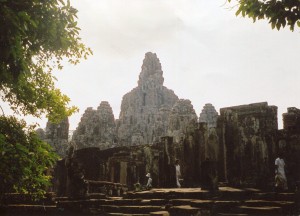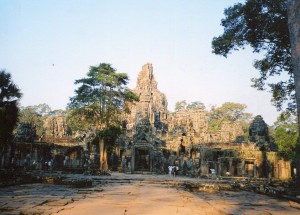If you have time for only two temples in Angkor, make sure that the 2nd one’s the Bayon.
It was begun around 1200, in the middle of the Khmer capital, Angkor Thom. Studying it brings you into the Khmer world during its zenith, and it reveals fascinating changes that had happened since Angkor Wat was finished about 50 years before. Claude Jacques called it one of the most mysterious and powerful religious buildings in the world.
King Jayavarman VII built it as his royal cult center after he began constructing the two huge monasteries/universities nearby, Ta Prohm and Preah Khan. The Bayon rises in the middle of Angkor Thom, and it was supposed to be the center of the Khmer universe. Ta Prohm and Preah Khan spread just outside the city walls. So the Bayon was the Khmer Empire’s centerpiece.
Many Khmer studies specialists have felt that the 3 great complexes were symbolically related. Ta Prohm was associated with Jayavarman’s mother and Prajnaparamita (a Mahayana Buddhist deity of wisdom). Preah Khan embodied his father and Lokesvara (a deity of compassion). The Bayon represented the Buddha and Jayavarman. David Chandler wondered if all 3 temples were thus related–wisdom/mother and compassion/dad gave birth to the Buddha/Jayavarman VII, who puts the whole universe in order.
Chandler was only speculating, but these buildings were probably symbolically related in some way, since they’re so big and close, and the same guy built them. And the Bayon was seen as Angkor’s center. So Khmers probably conceived of it in relation to the other great monuments. And what a center–
The word Bayon means ancestor yantra–a yantra is a complex symmetrical blend of shapes that represents the emanation of energies that the universe came from, and their differentiation into its different worlds. The Bayon has an outer enclosure that once housed statues of dozens of elites’ ancestors and gods (the people in the 2 photos above are meandering through its ruins).
And in the above shot, a reconstructed Buddha sculpture presides within it. So the Bayon didn’t just house the Buddha and the king. It blended Jayavarman’s Buddhism with traditional Khmer ancestor veneration. The Bayon is a who’s who in the Khmer universe while Europeans were building their Gothic cathedrals–they constructed Chartres at exactly the same time.
But we’re only in the Bayon’s outer area. A journey towards its center takes you through a multi-leveled world that’s so rich that it left me speechless. The next enclosure is covered with sculptures of gods, people and battles, as an enclosure in Angkor Wat is. But the Bayon’s friezes approach a revolution in perspective, which we’ll explore in the next post about this the Bayon.





Comments on this entry are closed.